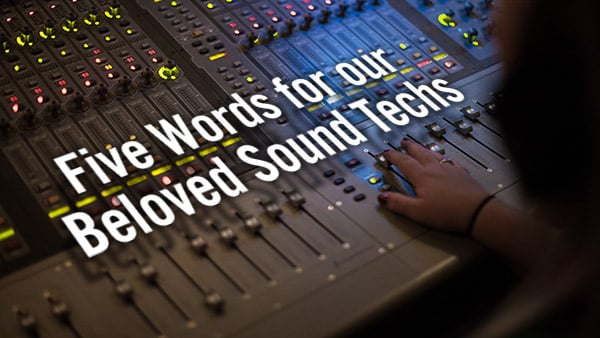
by Adam Kurihara from Seedbed.com
I love our sound techs. I love them because they are increasingly consistent, reliable, fun to work with, and eager to learn and grow. They respect the musicians, and they are always eager to help with additional services or projects. Though we are not a big church by any stretch of the imagination, we are privileged to have a team of 3-4 guys that give about 4 hours of their time on a Sunday to make sure we have excellent worship services.
Here are five qualities I encourage in our sound techs:
1. See yourself as part of the worship team.
The person sitting behind the mixer has as much influence on the service as the worship leader. Remember that you are doing so much more than setting levels and muting/un-muting microphones. You are shaping the tone of the service, from prelude to postlude (or, from pre-service background music to post-service worship-team jam). The job of sound guy or girl is not simply technical, it involves proactive decision making, spontaneity, and creativity.
Take for example the rehearsal time. As the band is practicing the music for Sunday, listen to the form of the song. If possible, get a copy of the charts so you can follow along with the form of the songs. You should know when there is an extended instrumental section and consider boosting lead instruments as they carry a melody. If a song starts with just pads/guitar and boost those to support the congregations voice before the other instruments come in, then bring them back down to sit in the mix when the full band is playing.
Another example: If the service starts with a three-song worship set, try starting with the master fader 20% below unity to allow the congregation to settle into the space and hear their voices. By allowing the congregation to hear themselves as active participants you set an important tone for the worship service – our voices are important! As each song progresses, boost the master fader up with the energy of the song to encourage the congregation to sing out even more.
In short, ride those faders! Listen, listen, listen, and adjust as needed.
2. Be the first (ok, maybe second) person to church.
Remember: If you’re early, you’re on time; if you’re on time, you’re late; and if you’re late…well, don’t be late! By arriving at the same time as the worship leader you can both get a head start on running lines and setting up microphones so that when it’s time for sound check things are ready to go.
Talk with the worship leader about time expectations for the morning. When is the band expected to arrive? Are they expected to help setup as well? By making clear expectations about arrival times and rehearsal start times, Sunday morning setup and rehearsal will be much more productive and everyone will be happier!
3. Think like a musician.
Be creative, especially during rehearsal. Listen, and listen some more. Are the musicians balanced? Are the singers able to be heard but not overpowering? If it’s too loud, can you identify what frequencies are too loud? Remember that you are the only member of the band that can actually hear what it’s like in the house, so use your ears! You don’t have to be a musician yourself, but you do have to know music, and know what sounds good. Even away from the board you can think like a musician. When you listen to music in your car or on your headphones, think about the mix, the EQ, how amazing that kick drum sounds and how you would achieve the same sound. Consider it all “sound tech practice!”
4. Communicate.
Talk to your musicians. Don’t be afraid to ask for what you need to help you shape the sound. Ask for each musician to play by themselves while you set gain, EQ, compression, etc…
While they are playing, consider their performance and how you can help them achieve a better sound. If a vocalist looks timid, turn them down in their monitor and tell them to sing out. If a guitarist is strumming too harshly ask them to move their strums away from the bridge and towards the fingerboard. Check mic placement. There are so many simple ways to influence tone before it gets to your board.
Part of your job is to make the band sound as good as possible, but sometimes the ‘raw material’ leaves something to be desired! Maybe you’re trying to shape a song to have contrasting dynamics but the band is playing everything medium-loud. Feel free to (kindly and respectfully) offer suggestions regarding dynamics or articulation. If the bass is boomy and muddy, EQ might help, but so will a cleaner attack and quicker release from the bass player or dampening the kick. If you’re thinking as a musician, then you know there are often a number of ways to fix a given problem. Consider the musician – how this real human is playing this real instrument – before you reach for that EQ, fader, or compressor.
Of course giving advice to singers and players is a sensitive topic. Read more thoughts on communicating with musicians here.
5. Never stop learning.
There’s always room to grow and improve your craft. Learn what every button, knob, and fader on your board and rack does. Learn about your tools: EQ, compression, reverb, gates, delays, and how to use them. Research new gear upgrades. Learn how to identify frequencies to nip feedback in the bud. Learn how our ears respond to sound pressure and how to make it sound “full” but not “loud”. Audio engineering takes decades to learn and master and there is so many resources out there. Not sure where to start? Check out blogs, listen to some live sound podcasts, visit other churches and see what they do, read lots of books and magazines.
--Adam Kurihara is the director of music and worship at Trinitarian Congregational Church in Wayland, MA. In addition to leading Sunday worship, he directs the worship team, the choir, small ensembles, and runs a seasonal concert series. Adam studied composition, piano, and choral conducting at UC Santa Barbara, and moved to Boston in 2010 to study sacred music at BU's School of Theology. This blog was originally published on August 17, 2015 on the Seedbed Worship Design Collective website which has graciously granted us permission to re-post. For more, go to worshipdesigncollective.seedbed.com
--For additional resources on team building for worship leaders, check out more blogs at discoverworship.com.






